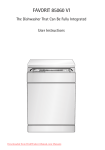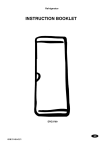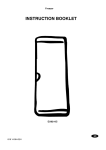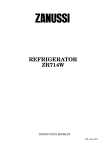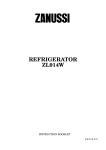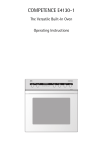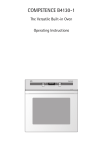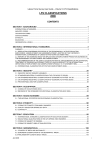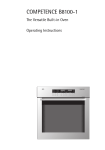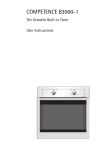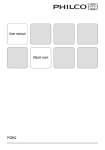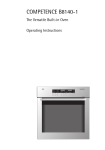Download Electrolux B8920 User's Manual
Transcript
COMPETENCE B8920 Built In Fan/Steam Oven Operating Instructions Installation Instructions Dear Customer, Please read through these instructions carefully. Pay special attention to the "Tips on Safety" on the first pages. Please keep the instructions in a safe place and refer to them when necessary. If re-selling the appliance, pass the instructions on to the new owner. The following symbols are used in the text: Safety tips : Caution! Notes that warn of a risk of serious injury. 1 Caution! Notes that concern your personal safety. 1 Important: Notes that show how to avoid damage to the appliance. 3 Useful hints and tips 2 Environmental information 1. These numbers are used to list the various steps for operating the appliance. 2. ... 3. ... Your local AEG SERVICE FORCE centre is available at all times to deal with technical problems (addresses and telephone numbers are listed under “Customer Service Centres”). For additional information, also see the section “Service”. Printed on paper produced from recycled materials. Those who think ecologically, act ecologically... 2 Contents Operating Instructions .................................... 5 Safety . . . . . . . . . . . . . . . . . . . . . . . . . . . . . . . . . . . . . . . . . . . . . . . . . . . . . . . . 5 Disposal . . . . . . . . . . . . . . . . . . . . . . . . . . . . . . . . . . . . . . . . . . . . . . . . . . . . . . 7 Description of the Appliance . . . . . . . . . . . . . . . . . . . . . . . . . . . . . . . . . . . . 8 General Overview . . . . . . . . . . . . . . . . . . . . . . . . . . . . . . . . . . . . . . . . . . . . . . . 8 Control Panel . . . . . . . . . . . . . . . . . . . . . . . . . . . . . . . . . . . . . . . . . . . . . . . . . . 8 Oven Features . . . . . . . . . . . . . . . . . . . . . . . . . . . . . . . . . . . . . . . . . . . . . . . . . . 9 Oven Accessories . . . . . . . . . . . . . . . . . . . . . . . . . . . . . . . . . . . . . . . . . . . . . . . 10 Before Using for the First Time . . . . . . . . . . . . . . . . . . . . . . . . . . . . . . . . . 11 Setting the Clock . . . . . . . . . . . . . . . . . . . . . . . . . . . . . . . . . . . . . . . . . . . . . . . 11 Initial Cleaning . . . . . . . . . . . . . . . . . . . . . . . . . . . . . . . . . . . . . . . . . . . . . . . . . 12 Operating the Oven . . . . . . . . . . . . . . . . . . . . . . . . . . . . . . . . . . . . . . . . . . . . The Electronic Oven Control . . . . . . . . . . . . . . . . . . . . . . . . . . . . . . . . . . . . . . Display Field . . . . . . . . . . . . . . . . . . . . . . . . . . . . . . . . . . . . . . . . . . . . . . . . Control Field . . . . . . . . . . . . . . . . . . . . . . . . . . . . . . . . . . . . . . . . . . . . . . . . Oven Functions . . . . . . . . . . . . . . . . . . . . . . . . . . . . . . . . . . . . . . . . . . . . . . . . Inserting the Oven Shelf, Tray, and All-Purpose Tray . . . . . . . . . . . . . . . . . Clock Functions . . . . . . . . . . . . . . . . . . . . . . . . . . . . . . . . . . . . . . . . . . . . . . . . Child Safety Device . . . . . . . . . . . . . . . . . . . . . . . . . . . . . . . . . . . . . . . . . . Oven Safety Cut-out . . . . . . . . . . . . . . . . . . . . . . . . . . . . . . . . . . . . . . . . . Steam Cooking Functions . . . . . . . . . . . . . . . . . . . . . . . . . . . . . . . . . . . . . . . . 13 13 13 13 15 19 22 29 30 31 Usage, Tables and Tips . . . . . . . . . . . . . . . . . . . . . . . . . . . . . . . . . . . . . . . . . Steam Cooking . . . . . . . . . . . . . . . . . . . . . . . . . . . . . . . . . . . . . . . . . . . . . . . . . Vigorous Steam Cooking . . . . . . . . . . . . . . . . . . . . . . . . . . . . . . . . . . . . . . . . . Vigorous Steam Cooking Table . . . . . . . . . . . . . . . . . . . . . . . . . . . . . . . . . Vigorous Steam and Fan Cooking in succession . . . . . . . . . . . . . . . . . . . . . . Vigorous Steam and Fan Cooking in Succession Table . . . . . . . . . . . . . . . . . . . . . . . . . . . . . . . . . . . . . . . . . Steam Interval Cooking . . . . . . . . . . . . . . . . . . . . . . . . . . . . . . . . . . . . . . . . . . Steam Interval Cooking Table . . . . . . . . . . . . . . . . . . . . . . . . . . . . . . . . . . Baking . . . . . . . . . . . . . . . . . . . . . . . . . . . . . . . . . . . . . . . . . . . . . . . . . . . . . . . . Baking Table . . . . . . . . . . . . . . . . . . . . . . . . . . . . . . . . . . . . . . . . . . . . . . . . Tips on Baking . . . . . . . . . . . . . . . . . . . . . . . . . . . . . . . . . . . . . . . . . . . . . . Pies and Gratin Table . . . . . . . . . . . . . . . . . . . . . . . . . . . . . . . . . . . . . . . . . Frozen Ready Meals Table . . . . . . . . . . . . . . . . . . . . . . . . . . . . . . . . . . . . . 33 33 34 35 36 36 37 37 38 40 43 44 45 3 Roasting . . . . . . . . . . . . . . . . . . . . . . . . . . . . . . . . . . . . . . . . . . . . . . . . . . . . . . Roasting Table . . . . . . . . . . . . . . . . . . . . . . . . . . . . . . . . . . . . . . . . . . . . . . Meat Probe Table . . . . . . . . . . . . . . . . . . . . . . . . . . . . . . . . . . . . . . . . . . . . Grill Sizes . . . . . . . . . . . . . . . . . . . . . . . . . . . . . . . . . . . . . . . . . . . . . . . . . . . . . Grilling Table . . . . . . . . . . . . . . . . . . . . . . . . . . . . . . . . . . . . . . . . . . . . . . . Defrosting . . . . . . . . . . . . . . . . . . . . . . . . . . . . . . . . . . . . . . . . . . . . . . . . . . . . . Defrosting table . . . . . . . . . . . . . . . . . . . . . . . . . . . . . . . . . . . . . . . . . . . . . Drying . . . . . . . . . . . . . . . . . . . . . . . . . . . . . . . . . . . . . . . . . . . . . . . . . . . . . . . . Drying Table . . . . . . . . . . . . . . . . . . . . . . . . . . . . . . . . . . . . . . . . . . . . . . . . Low Temperature Cooking . . . . . . . . . . . . . . . . . . . . . . . . . . . . . . . . . . . . . . . Low Temperature Cooking Table . . . . . . . . . . . . . . . . . . . . . . . . . . . . . . . Bio Functions . . . . . . . . . . . . . . . . . . . . . . . . . . . . . . . . . . . . . . . . . . . . . . . . . . Making Yoghurt . . . . . . . . . . . . . . . . . . . . . . . . . . . . . . . . . . . . . . . . . . . . . Raising yeast dough . . . . . . . . . . . . . . . . . . . . . . . . . . . . . . . . . . . . . . . . . . Making Preserves . . . . . . . . . . . . . . . . . . . . . . . . . . . . . . . . . . . . . . . . . . . . . . . Preserving Table . . . . . . . . . . . . . . . . . . . . . . . . . . . . . . . . . . . . . . . . . . . . . 46 48 50 51 51 52 52 53 53 54 54 55 55 56 57 58 Cleaning and Care . . . . . . . . . . . . . . . . . . . . . . . . . . . . . . . . . . . . . . . . . . . . . Exterior of the Appliance . . . . . . . . . . . . . . . . . . . . . . . . . . . . . . . . . . . . . . . . Oven Interior . . . . . . . . . . . . . . . . . . . . . . . . . . . . . . . . . . . . . . . . . . . . . . . . . . Accessories . . . . . . . . . . . . . . . . . . . . . . . . . . . . . . . . . . . . . . . . . . . . . . . . . . . . Side Rails . . . . . . . . . . . . . . . . . . . . . . . . . . . . . . . . . . . . . . . . . . . . . . . . . . . . . . Steam Generation System . . . . . . . . . . . . . . . . . . . . . . . . . . . . . . . . . . . . . . . Oven Light . . . . . . . . . . . . . . . . . . . . . . . . . . . . . . . . . . . . . . . . . . . . . . . . . . . . 59 59 59 59 60 62 63 What to do if ... . . . . . . . . . . . . . . . . . . . . . . . . . . . . . . . . . . . . . . . . . . . . . . . 65 Service Symbol and Error Codes . . . . . . . . . . . . . . . . . . . . . . . . . . . . . . . . . . . 66 Technical Data . . . . . . . . . . . . . . . . . . . . . . . . . . . . . . . . . . . . . . . . . . . . . . . . 67 Oven Internal Dimensions . . . . . . . . . . . . . . . . . . . . . . . . . . . . . . . . . . . . . . . . 67 Regulations, Standards, Directives . . . . . . . . . . . . . . . . . . . . . . . . . . . . . . . . . 67 Installation Instructions . . . . . . . . . . . . . . . . . . . . . . . . . . . . . . . . . . . 68 Safety Instructions for the Installer . . . . . . . . . . . . . . . . . . . . . . . . . . . . . . . . 68 Index . . . . . . . . . . . . . . . . . . . . . . . . . . . . . . . . . . . . . . . . . . . . . . . . . . . . . . . . . 74 Service & Spare parts 4 . . . . . . . . . . . . . . . . . . . . . . . . . . . . . . . . . . . . . 75 Operating Instructions Operating Instructions 1 Safety Electrical Safety • This appliance must be connected by a specially licensed technician only. • In the event of a fault or damage to the appliance, take out the fuses, or switch off. • For safety reasons, do not clean the appliance with steam jet or highpressure cleaning equipment. • Repairs to the appliance must be carried out by a specially licensed technician only. Considerable danger may result from incorrect repairs. If repairs become necessary, please contact our Customer Services, or your dealer. Child Safety • Never leave children unsupervised when the appliance is in use. Safety during Operation This appliance should be used only for the cooking, roasting, baking, etc. of household foods. • Be careful if connecting electrical appliances to sockets near to this appliance. Electrical leads and cables should not be allowed to come near the hotplates or to become caught under the hot oven door. • Caution! Danger of burns! When in use, the oven interior surfaces become very hot! • Caution! Do not in any circumstances open the oven door during steam cooking. The escaping steam can cause moisture damage to furniture. Avoid any direct contact with escaping steam. • If alcohol ingredients are placed inside the oven, these can give rise to a mildly inflammable air/alcohol mixture. In this case, be careful when opening the door. Do not use any sources of direct heat, sparks, or naked flames, near the oven. 5 Operating Instructions Avoiding damage to the appliance: • Do not lay aluminium foil, or place baking trays , pots, etc. on the oven floor, as the heat built up will damage the oven surface enamel. • Fruit juices dripping from the baking tray will leave stains, which become indelible. For very moist cakes, use the all-purpose tray. • Do not put any strain on the oven door. • Never pour water directly into the oven. This could cause electrical faults, or damage to the enamel. • Rough handling, especially around the edges of the front panel, can cause the glass to break. • Do not store any inflammable materials inside the oven. These could ignite when the oven is switched on. • Do not store any moist foods inside the oven. This could damage the oven surface enamel. 6 Operating Instructions 2 Disposal Disposing of the packaging material All materials used can be fully recycled. Plastics are marked as follows: • >PE< for polyethylene, as used for the outer wrapping and the bags inside. • >PS< for polystyrene foam, e.g., as used for the padding materials. They are completely free of CFCs. Disposal of old appliances 1 Warning: Before disposing of old appliances please make them inoperable so that they cannot be the source of danger. To do this, disconnect the appliance from the mains supply and remove the mains lead. To protect the environment, it is important that worn out appliances are disposed of in the correct manner. • The appliance must not be disposed of with household rubbish. • You can obtain information about collection dates or public refuse disposal sites from your local refuse department or council. 7 Operating Instructions Description of the Appliance General Overview Control Panel 8 Operating Instructions Oven Features 9 Operating Instructions Oven Accessories Combination shelf For dishes, cake tins, roasting and grilling trays. Baking Tray For cakes and biscuits (not suitable for steam cooking) All-Purpose Tray For roasting, or collecting meat juices or fat (not suitable for steam cooking) Inner tray For fatty meat (for positioning in the All-Purpose tray, not suitable for steam cooking) Meat Probe Used to determine the condition of meats while cooking (not suitable for steam cooking) 10 Operating Instructions Before Using for the First Time Setting the Clock 3 The oven only operates when the clock has been set. «12:00» flashes on the clock display when the appliance is first connected, or after a power cut. 1. Press the CLOCK W button. «:» flashes. 2. Start setting the current time within 4 seconds, using the i or j buttons. Wait for about 4 seconds. The clock stops flashing and shows the set clock time. The appliance is now ready to use. 11 Operating Instructions Initial Cleaning You should clean the oven thoroughly before using for the first time. 1 Important: do not use sharp or abrasive cleaning materials! These could damage the oven surface. 3 For ovens with metal fronts, use commercially available cleaning agents. 1. Press the ON H button: the oven light comes on. Open the door. 2. Clean all oven trays and accessories, and the side rails, with warm water and washing-up liquid. 3. Wash the oven in the same way, with warm water and washing-up liquid, and leave to dry. 4. Wipe the front of the appliance with a damp cloth. 12 Operating Instructions Operating the Oven The Electronic Oven Control Display Field Control Field 13 Operating Instructions 3 General Tips • The sensors behind the glass panel react to a deliberate (not too short) touch with the fingertip on one of the touch-control buttons (dipped finger guide). The following are ineffective: – touching with the fingernail only, – putting the fingertip near the touch control button, – a short touch with the fingertip, – touching a touch-control button when wearing a glove. • Always switch the oven on first with the ON H button. Exception: COUNTDOWN V. • Begin selecting the desired settings within 4 seconds. An audible signal confirms that the 4 seconds have elapsed. When the desired function button has been pressed, new settings can be selected. • Three short audible signals indicate an incorrect setting. In this case, press the OFF I button and start again with the ON H button. • Switch off the oven with the OFF I button. 14 Operating Instructions Oven Functions The oven has the following functions: ¾ Vigorous Steam Cooking Fixed temperature setting: 96°C. For vegetables, potatoes, rice, pasta or special side-dishes. Steam generator and fan are on. ½ Steam Interval Suggested temperature: 180°C. For baking, cooking and warming up frozen or chilled foods. Hot air and steam generator operate alternately. » Fan Cooking Suggested temperature: 150°C. For baking on up to three oven levels, and for roasting. The fan and the rear heating element are on. ¼ Pizza Setting Suggested temperature: 230°C. For baking cakes on one oven level, and pastries or biscuits that require more intensive browning and a crispy base or crust. This might include, for example, pizzas, quiche, fruit cakes, cheesecake, etc. Bottom heat, rear heating element, and fan are on. ¿ Rotitherm Suggested temperature: 180°C. For roasting larger joints of meat or poultry on one oven level. This function is also suitable for gratin and soufflés. The grill heating element and fan operate alternately. 15 Operating Instructions À Single Grill Suggested temperature: 230°C. For grilling flat foods placed in the centre of the shelf, for example, steaks, escalopes, fish; or for toasting. The grill heating element is on. Á Dual Grill Suggested temperature: 230°C. For grilling flat foods in large quantities, for example, steaks, escalopes, fish; or for toasting. Top heat and grill heating element are on.  Conventional Use (Top/Bottom Heat) Suggested temperature: 200°C. For baking and roasting on one oven level. Top/bottom heating elements are on. à Defrost/ Dry Suggested temperature: 40°C. For defrosting or drying herbs, fruit, and vegetables. Bottom heating element and fan are on. » ¸ Low Temperature Cooking Temperature setting: 120/80°C. For preparing especially tender, juicy roasts. Rear heating element and fan are on. 16 Operating Instructions Switching on the Oven Function 1. Switch on the oven with the ON H button. 2. Press the OVEN FUNCTION Ë button till the desired function is lit. The symbol for the selected function appears in the display field. A suggested temperature appears on the temperature display. Changing the oven temperature Press the i or j button, to raise or lower the temperature. The setting changes in steps of 5°C. 17 Operating Instructions Changing the oven function Press the OVEN FUNCTION Ë button as often as necessary, till the desired function is lit. Switching off the oven Switch off the oven with the OFF I button. 18 3 Cooling fan When the oven is switched on, the fan comes on automatically to keep the oven surfaces cool. When the oven is switched off, the fan continues to run to cool the appliance down, then switches itself off. 3 Residual Heat Indicator The residual heat is indicated until the temperature has gone down to 40°C. Operating Instructions Inserting the Oven Shelf, Tray, and All-Purpose Tray 3 Anti-tip device All trays and shelves have a little curve on the left and right edges. This curve serves as an anti-tip device and must always be turned towards the back of the oven. Inserting the shelf: Insert the shelf at the desired level. Inserting the tray and all-purpose tray: Insert the tray and/or all-purpose tray at the desired level. 19 Operating Instructions Meat Probe For switching off the oven when the temperature at the centre of a roast reaches a set temperature. The meat probe is used with the Conventional (Top/Bottom heating) Â, Fan Cooking » and Rotitherm ¿ functions. There are two temperatures to be set: • Oven temperature (see Chapter "Type of use, Tables...: Roasting Tables") • Core temperature (see Chapter "Type of use, Tables...: Meat Probe Table") 1 Important: Use only the meat probe supplied! If replacing, please use only original replacement parts. 1. Where possible, push the meat probe fully into the meat, so that the point is in the centre. 2. Plug the meat probe into the socket on the side of the oven, pushing in fully. È is lit red. 3. Set the desired oven function and temperature. È is lit white. 4. Press the MEAT PROBE Ê button. The temperature display indicates 70°C as the suggested temperature for the core temperature of the roast. 20 Operating Instructions 5. You can change the core temperature to the desired setting using the i or j buttons. After about 5 seconds, on the right of the time display appears the current core temperature of the roast. The core temperature is displayed starting from 30°C. 3 Checking or changing the core temperature • Press the MEAT PROBE Ê button to show the set core temperature. • Press the MEAT PROBE Ê button, and then press the i or j button several times to adjust the selected core temperature. When the core temperature detected reaches the selected core temperature, an audible signal is sounded and the function display flashes. The heating is switched off automatically. 6. Stop the signal by pressing the i or j button. Switch off the oven with the OFF I button. Caution! The meat probe becomes very hot. Be careful when taking out the plug and extracting the meat probe! 7. Remove the meat probe plug from the socket, and take the meat out of the oven with the meat probe still inserted. 1 3 After 2 minutes, the appliance switches off automatically. 21 Operating Instructions Clock Functions Countdown C To set a countdown. A signal sounds after the time has elapsed. This function does not affect the functioning of the oven. Cook time < To set how long the oven is to be in use. End time > To set when the oven is to switch off again. Time D To set, change or check the time. (See also section “Before Using for the First Time”.) 3 22 General Tips • After a Clock function has been selected, the clock display flashes for about 4 seconds. While it flashes, the desired time can be set using the i or j buttons. • When the desired time has been set, the display flashes again for around 4 seconds. The function concerned is then lit. The set time begins to run. • Press any of the Clock function buttons to stop the audible signal. Operating Instructions COUNTDOWN 1. Press the COUNTDOWN V button. Ä flashes. 2. The desired Countdown time can be set with the i or j button, up to 9 hours 59 minutes). When the set time has elapsed, Ä flashes, and an audible signal is sounded for 2 minutes. To turn off the audible signal: Press the COUNTDOWN V button. 23 Operating Instructions COOK TIME 1. Switch on the appliance. 2. Select the desired oven function and temperature. 3. Press the COOK TIME Ì button. Ì flashes. 4. Set the desired cooking time with the i or j button. When the time has elapsed, Ì flashes, an audible signal sounds for 2 minutes, and the oven switches itself off. To turn off the audible signal: Press the OFF I button. 24 Operating Instructions END 1. Switch on the appliance. 2. Select the desired oven function and temperature. 3. Press the END Í button. Í and «:» are flashing. 4. Set the desired switch-off time with the i or j button. When the time has elapsed, the oven function flashes, an audible signal is sounded for 2 minutes, and the oven switches itself off. To turn off the audible signal: Press the OFF I button. 25 Operating Instructions Combining the COOK TIME and END functions 3 The COOK TIME Ì and END Í functions can be combined, to switch the oven on or off automatically at a later time. 1. Switch on the appliance. 2. Select the desired oven function and temperature. 3. Using COOK TIME Ì, set the time required for cooking the dish concerned, for example, 1 hour. 4. Using END Í, set the time at which the dish should be ready, for example, 14:05. 26 Operating Instructions Oven functions COOK TIME Ì and END Í are lit on the display, and the current time appears, in this case 12:05. The oven switches off automatically when the set time is reached, for example, 13:05. When the set cooking time has elapsed, an audible signal is sounded for 2 minutes and the oven switches itself off, for example, 13:05. COOK TIME Ì and END Í appear flashing on the display. 27 Operating Instructions Adjusting the clock TIME 1. Press the CLOCK X button. 2. Set the current time with the i or j button. After about 4 seconds, the clock stops flashing and shows the set clock time. The appliance is now ready to use. 3 28 The clock can only be adjusted if the oven is off and the Child Safety device has not been set. Operating Instructions Child Safety Device The oven is fitted with a child safety device. When the child safety device is engaged, the oven cannot be switched on. 3 To engage the child safety device, none of the oven functions must be currently selected. Activating the child safety device 1. Press and hold the CHILD SAFETY r button, then press and hold the ON H button for around 4 seconds, until Å appears on the display field. 2. Switch off the oven with the OFF I button. The child safety device is now engaged. Releasing the Child Safety Device Press OFF I and CHILD SAFETY r at the same time, until Å disappears from the display. The child safety device is now released, and the oven is ready for use. 3 Switching off the oven with the OFF I button does not release the Child Safety device. 29 Operating Instructions Oven Safety Cut-out 3 If not switched off after a certain time, or if the temperature does not change, the oven switches off automatically. The oven switches off at temperatures of: < 120°C 120°C up to < 230°C 230°C or > after after after Switching on after a safety cut-out Switch the oven off completely. It can then be switched on again. 30 16 hours 8 hours 4 hours Operating Instructions Steam Cooking Functions 1 Important: The Steam functions must always be used in conjunction with the Clock functions COOK TIME Ì or END Í (see Chapter "Clock functions: COOK TIME/END“). 1 Important: Always use water only! A dial tone is sounded when the water has been used up. When more water is added, the dial tone goes off again. 3 To prevent limescale forming, use softened water only, for example, through a water filtering appliance. 3 Due to the automatic steam dispersal period of about 5 minutes at the end of cooking time, and the warm-up period of around 2 minutes, settings under 10 minutes have little effect. During steam dispersal, the oven door can mist up slightly. Steam will also escape when the door is opened. The slight misting on the control panel quickly evaporates. Vigorous steam 1. The water (about 700 ml) is not poured directly into the steam generator, but into the drawer in the control panel. The water supply lasts for around 30 minutes. 2. Switch the oven on with the ON H button. 3. Using the OVEN FUNCTION button Ë, select the Vigorous Steam ¾ function. 31 Operating Instructions 4. Press the COOK TIME Ì or END Í button and, using the i or j button, set the desired cooking time or switch-off time. After about 2 minutes, the first steam appears. A single audible signal indicates when the cooking temperature of around 96°C is reached. Three signals are sounded at the end of cooking time. 5. Stop the signal and switch off the oven by pressing the OFF I button. After the oven has cooled down, soak up any remaining water from the steam generator and wipe if necessary with a few drops of vinegar. Leave the door open to let the oven dry out. Steam Interval Changing from hot air to steam takes place automatically. 1. The water (about. 250 ml) is not poured directly into the steam generator, but into the drawer in the control panel. The water supply lasts for around 60 minutes. 2. Switch the oven on with the ON H button. 3. Using the OVEN FUNCTION button Ë, select the Steam Interval function ½ and set the desired temperature with the i or j button. 4. Press the COOK TIME Ì or END Í button and, using the i or j button, set the desired cooking time or switch-off time. Then proceed as for Vigorous Steam. 32 Operating Instructions Usage, Tables and Tips Steam Cooking For steam cooking, use either the Vigorous Steam ¾ or Steam Interval ½ oven functions. 1 Caution! During steam cooking, do not in any circumstances open the oven door ! 1 Important: Always use water only! Steam Cooking Dishes • Ordinary oven tins, heat-resistant tins, and roasting dishes are suitable for steam cooking. • Do not use enamelled baking tins! Chrome steel food containers are also very suitable. Oven levels • The appropriate oven level can be found in the following table. • Be careful to count oven levels starting from the bottom. 3 General Tips • For cooking times longer than 30 minutes, or larger items, top up with water if necessary. • With Vigorous Steam ¾ and Steam Interval ½, take out the grease filter; otherwise, cooking time is longer. • If not used for long periods, thoroughly rinse out the water drawer, connecting hoses, and steam generator (see Chapter "Care and Cleaning"). 33 Operating Instructions How to use the Steam Cooking Tables The tables give the required temperature settings, cooking times, and oven levels for a selection of typical dishes. • Temperatures and steam cooking times are for guidance only, as these will depend on the consistency and size of the food, quantity, and type of oven tin or dish. • If you cannot find the settings for a particular recipe, look for the one that is most similar. • Unless otherwise stated, the values given in the tables assume that steam cooking is started with the oven cold. Vigorous Steam Cooking Vigorous Steam ¾ cooking is suitable for all types of food, fresh or frozen. It can be used for cooking, defrosting, warming, poaching, or blanching vegetables, meat, fish, pastries, rice, sweet corn, semolina, and eggs. A complete menu can be prepared at one time, on the serving dishes, irrespective of quantity or cooking time. The following table provides a guide. 34 Operating Instructions Vigorous Steam Cooking Table Vigorous Steam ¾ Oven Level Time in mins. Risotto 2 25-30 Rice 2 35-40 Jacket potatoes 2 35-45 Boiled potatoes 2 35-40 Sauerkraut 2 50-60 Ratatouille 2 25-30 Brussels sprouts 2 30-35 Cauliflower, whole 2 35-40 Tomatoes, whole 2 15-20 Beetroot, whole 2 60-70 Kohlrabi / Celery / Fennel, chopped 2 35-40 Courgettes, chopped 2 20-25 Carrots, chopped 2 30-35 Defrosting and cooking vegetables 2 30-35 Blanching beans 2 20-22 Blanching vegetables 2 12-15 Smoked loin of pork 600-1000 g 2 45-55 Meat loaf in 1 cm slices 2 20-25 Trout, 170-300 g 2 15-25 Eggs, soft 2 8-10 Eggs, medium 2 10-12 Eggs, hard 2 15-20 Type of recipe 35 Operating Instructions Vigorous Steam and Fan Cooking in succession Vigorous Steam ¾ and Fan Cooking » can combined, using one after the other, then using them together to cook vegetables, meat, sidedishes in the oven, so that they will be ready to serve at the same time. • Cook roast meats with the Fan Cooking » function. • Prepare the vegetables and side-dishes, put in heat-proof dishes, and place in the oven. • Start Vigorous Steam ¾, and cook it all together till ready. 3 Before using the Vigorous Steam ¾ function, the oven must be cooled to a temperature of around 85°C (check temperature display). For faster cooling, open the oven door. Vigorous Steam and Fan Cooking in Succession Table Vigorous Steam ¾ and Fan Cooking » in Succession Type of Recipe Meat and Meat Change Oven Temp. side-dishes Oven Time in oven Function in °C level Time in mins. function mins. Roast meat 1 kg, Brussels sprouts, Polenta » 180 50-60 ¾ 30-35 1 3 Roast pork 1 kg, Potatoes, Vegetables, Sauce/gravy » 180 40-50 ¾ 30-35 1 3 Roast veal 1 kg, Rice, Vegetables » 180 40-50 ¾ 30-35 1 3 Chicken 1 kg Roast potatoes Tomatoes au gratin » 190 40-50 ½ 30 10 1 4 Core temperature of meat should be around 60-63°C before switching to Vigorous Steam. 36 Operating Instructions Steam Interval Cooking Steam Interval ½ cooking is particularly suitable for roasting large joints of meat, and defrosting or re-heating food portions cooked previously. Steam Interval Cooking Table Cooking on more than one oven level Steam Interval ½ Temperature in °C Time in mins. Oven Level Complete meal recombined 6 plates, dia. 24 cm 120 15-20 1, 3 and 5 Roast pork 1 kg 180 55-65 2 Roast meat 1 kg 180 55-65 2 Roast veal 1 kg 180 45-55 2 Meat loaf, uncooked, 500 g 180 30-40 2 Veal sausage 90 15-20 2 Frankfurter 90 15-20 2 Smoked loin of pork 600-1000 g 180 35-45 2 Chicken , 1 kg 180 45-55 2 Duck, 1.5-2 kg 180 55-65 2 Goose, 3 kg 170 130-170 1 Fish fillet 90 10-15 2 Potatoes au gratin Leek/potatoes au gratin 180 40-50 2 Pasta soufflé 180 35-45 2 Lasagne 180 45-50 2 Misc. types of bread 500-1000 g 190-200 50-60 2 Rolls 50-60 g 200-210 20-25 2 Type of food Cut open a whole roast before warming. 37 Operating Instructions Baking For baking, use either the Fan Cooking », Pizza setting ¼ or Conventional  oven functions. Baking Tins • For Conventional  baking (Top/Bottom heat), use dark metal or coated tins. • For Fan Cooking » or the Pizza setting ¼, bright metal tins are also suitable. Oven levels • Conventional baking  is only possible on one level. • With Fan Cooking », you can bake biscuits and cookies on up to 3 baking trays at the same time. 38 1 Baking tray: for example, oven level 3 1 Baking tin: for. example, oven level 1 2 baking trays Oven levels 1 and 4 3 baking trays: Oven levels 1, 3 and 5 Operating Instructions 3 General Tips • When baking, take out the grease filter, as otherwise baking time is prolonged and top surfaces are browned unevenly. • Be careful to count oven levels starting from the bottom. • Insert the baking tray with the bevel at the front! • Always place cakes in tins in the middle of the shelf. • With Fan Cooking » or Conventional  baking, you can simultaneously bake two tins placed beside each other on the shelf. This does not significantly increase baking time. How to use the Baking Tables The tables give the required temperature settings, baking times, and oven levels for a selection of typical dishes. • Temperatures and baking times are for guidance only, as these will depend on the consistency of pastry, volume, and the type of baking tin. • We recommend starting with the lower temperature, and then choosing a higher setting as necessary, for example, if a deeper browning is required, or baking time is too long. • If you cannot find the settings for a particular recipe, look for the one that is most similar. • If baking cakes on baking trays or tins on more than one level, baking time can be extended by 10-15 minutes. • Moist cakes (for example, pizzas, fruit cakes, etc.) are baked on one level. • Cakes and pastries of different heights may brown at an uneven rate at first. If this occurs, please do not change the temperature setting. Different rates of browning even out as baking progresses. 2 With longer baking times, the oven can be switched off about 10 minutes before the end of baking time, to make use of the residual heat. Unless otherwise stated, the values given in the tables assume that baking is started with the oven cold. 39 Operating Instructions Baking Table Baking on one level Fan Cooking » Conventional  Time Oven level, from bottom Temperature ºC Oven level, from bottom Temperature ºC Ring cake or brioche 1 150-160 1 160-180 0:50-1:10 Short bread/'galettes' 1 140-160 1 150-170 1:10-1:30 Sponge biscuit 1 150-160 1 160-180 0:25-0:40 Flan base - Short pastry 3 170-180 2 190-2101 0:10-0:25 Flan base - Cake mixture 3 150-170 2 170-190 0:20-0:25 Apple pie 1 150-170 1 170-190 0:50-1:00 Spicy cakes and flans (for example, Quiche Lorraine) 1 160-180 1 190-210 0:30-1:10 Cheese cake 1 140-160 1 170-190 1:00-1:30 Plaited buns/pastries 3 160-170 3 170-190 0:30-0:40 Christmas loaf 3 .150-1701 3 160-1801 0:40-1:00 Bread (rye bread) at first .....................................then 1 . 180-2001 140-160 2 2301 160-180 0:20 0:30-1:00 Vol-au-vent / Eclairs 3 160-1701 3 190-210 0:15-0:30 Swiss Roll 3 150-1701 3 180-2001 0:10-0:20 Dry streusel cake 3 150-160 3 160-180 0:20-0:40 Butter/sugar cakes, 3 160-1701 3 190-2101 0:15-0:30 Fruit cakes (made with yeast dough/ cake mixture)2 3 150-170 3 170-190 0:25-0:50 Recipe type for both functions Hrs. mins. Cakes in tins Cakes on baking trays 40 Operating Instructions Fan Cooking » Conventional  Time Oven level, from bottom Temperature ºC Oven level, from bottom Temperature ºC Fruit cakes made with short pastry1 3 160-170 3 170-190 0:40-1:20 Tray cakes with delicate toppings/fillings for example, cottage cheese, cream, sugar and almond toppings) - . 3 160-1801 0:40-1:20 Pizza (with many toppings)2 1 180-200 1 190-2101 0:30-1:00 Pizza (thin crust) 1 200-220 1 2301 0:10-0:25 Unleavened bread 1 200-220 1 2301 0:08-0:15 Tarts (CH) 1 180-200 1 210-230 0:35-0:50 Short pastry biscuits 3 150-160 3 170-1901 0:06-0:20 Dressed biscuits 3 140-150 3 160-180 0:10-0:40 Biscuits made with biscuit/cake mixture 3 150-160 3 170-190 0:15-0:20 Pastries made with egg white, meringues 3 80-100 3 100-120 2:00-2:30 Macaroons 3 100-120 3 120-140 0:30-0:60 Biscuits made with yeast dough 3 160-170 3 170-190 0:20-0:40 Puff pastries 3 160-1701801 3 190-2101 0:20-0:30 Rolls 3 180-2001 3 180-2201 0:20-0:35 Recipe type for both functions Hrs. mins. Biscuits 1) Pre-heat the oven! 2) Use the all-purpose tray! The numbers printed in bold indicate the recommended oven setting. 41 Operating Instructions Baking on more than one oven level Fan Cooking » Recipe type oven level, from bottom Temperature in °C Time Hrs.: mins. 2 levels 3 levels Vol-au-vent / Eclairs 1/4 - 160-1801 0:35-0:60 Dry streusel cake 1/4 - 140-160 0:30-0:60 Short pastry biscuits 1/4 1/3/5 150-160 0:15-0:35 Dressed biscuits 1/4 1/3/5 140-150 0:20-0:60 Biscuits made with biscuit/ cake mixture 1/4 - 160-170 0:25-0:40 Pastries made with egg white, meringues 1/4 - 80-100 2:10-2:50 Macaroons 1/4 - 100-120 0:40-1:20 Biscuits made with yeast dough 1/4 - 160-170 0:30-0:60 Puff pastries 1/4 - 170-1801 0:30-0:50 Rolls 1/4 - 180-1901 0:30-0:55 Cakes/pastries on baking tray Biscuits 42 Operating Instructions Tips on Baking Baking Results The cake is not browned enough at the bottom The cake sinks (becomes soggy, lumpy, streaky) Cakes are too dry Possible Cause Wrong oven level Place cake further in or, Place the shelf at a different level Oven temperature too high Use a slightly lower setting Baking time too short Set a longer baking time Baking times cannot be reduced by setting higher temperatures Too much liquid in the dough Use less liquid next time. Pay attention to mixing times, especially if using mixing machines Oven temperature too low Set a slightly higher oven temperature next time Baking time too long Set a shorter baking time Cakes brown unevenly Oven temperature too high and baking time too short Baking time too long Remedy Set a slightly lower temperature and longer baking time Yeast is spread unevenly Spread the dough evenly on the baking tray Grease filter is inserted Take out the grease filter Temperature too low Set a slightly higher oven temperature next time Grease filter is inserted Take out the grease filter 43 Operating Instructions Pies and Gratin Table Conventional O Shelf position from bottom Temp. °C Rotitherm I Shelf position from bottom Time Temp. °C Hrs: Mins. Pasta bake 1 180-200 1 160-170 0:45-1:00 Lasagne 1 180-200 1 160-170 0:25-0:40 Vegetables au gratin1 1 200-220 1 160-170 0:15-0:30 Pizza baguettes1 1 200-220 1 160-170 0:15-0:30 Sweet soufflés 1 180-200 - - 0:40-0:60 Fish pies 1 180-200 1 160-170 0:30-1:00 Stuffed vegetables 1 180-200 1 160-170 0:30-1:00 1) Pre-heat the oven. Information printed in bold type indicates the preferred oven function for the dish. 44 Operating Instructions Frozen Ready Meals Table Food to be cooked Shelf position from bottom Oven function Frozen pizza 3 Conventional O Chips1 (300-600 g) 3 Rotitherm I 3 Conventional O in accordance in accordance with the with the maker's maker's instrucinstructions tions 3 Conventional O in accordance in accordance with the with the maker's maker's instrucinstructions tions Baguettes Fruit flan Temperature Time in accordance in accordance with the with the maker's maker's instrucinstructions tions 200-220 °C 15-25 Mins. 1) Comment: Turn chips 2-3 times during cooking. 3 When frozen foods are used the trays inserted may distort during cooking. This is because of the large differences in temperature between the frozen item and the oven. Once the trays have cooled the distortion will disappear again. 45 Operating Instructions Roasting For roasting, use either the Rotitherm ¿ or Conventional  oven functions. Roasting dishes • Any heat-resistant ovenware is suitable for roasting (please read the manufacturer's instructions). • for roasting dishes with plastic handles, make sure that these are heat-resistant (please read the manufacturer's instructions). • Large roasts can be placed directly in the all-purpose tray, or on the shelf with the all-purpose tray placed underneath, (for example, turkey, goose, 3-4 chickens, 3-4 knuckles of veal). • For lean meats, we recommend roasting these in a casserole with a lid (for example, veal, braised beef, deep-frozen meats). This makes the meat juicier. • To make crackling, meats can be roasted in the casserole without the lid (for example, pork, mince, lamb, mutton, duck, knuckles of veal, chicken, small poultry, roast beef, fillet of beef, game fowl). 3 Tip: Roasting inside ovenware keeps the oven cleaner! Oven levels The appropriate oven level can be found in the following table. 46 Operating Instructions How to use the Roasting Table The table gives the required temperatures, cooking times, and oven levels for various types of meat. These are for guidance only. • We recommend cooking meat and fish from 1 kg in weight in the oven. • In general, the Conventional  oven function is particularly suitable lean meats and fish. For all other types of meat, we recommend using the Rotitherm ¿ oven function. • To prevent meat juices or fat from burning and sticking to the dish, we recommend adding some liquid. • Turn the meat as required (at about 1/2 - 2/3 of cooking time). 3 Tip: Baste large roasts and poultry with their juices several times while roasting. This will give better results. 2 Switch the oven off 10 minutes before the end of roasting time, to make use of the residual heat. 47 Operating Instructions Roasting Table Quantity Type of Meat Conventional  Rotitherm ¿ Time Weight Oven Level from Bottom Tempe rature ºC Oven Level from Bottom Tempe rature ºC Hrs. mins. 1-1.5 kg 2 200-230 - - 2:00-2:30 Beef Pot roast Roast beef or fillet each cm. thick - inside raw each cm. thick 2 2301 2 190-200 0:05-0:06 - inside rare each cm. thick 2 2301 2 180-190 0:06-0:08 - well done each cm. thick 2 210-2301 2 170-180 0:08-0:10 Shoulder, Neck, Ham 1-1.5 kg 2 210-220 2 160-180 1:30-2:00 Cutlet, Loin 1-1.5 kg 2 180-190 2 170-180 1:00-1:30 Meat loaf 750 g-1 kg 2 170-180 2 160-170 0:45-1:00 Knuckles of pork (pre-cooked) 750 g-1 kg 2 210-220 2 150-170 1:30-2:00 1 kg 2 210-220 2 160-180 1:30-2:00 1.5-2 kg 2 210-225 2 160-180 2:00-2:30 Leg of lamb, Roast lamb 1-1.5 kg 2 210-220 2 150-170 1:15-2:00 Saddle of lamb 1-1.5 kg 2 210-220 2 160-180 1:00-1:30 Pork Veal Roast veal Knuckles of veal Lamb 48 Operating Instructions Quantity Conventional  Rotitherm ¿ Time Weight Oven Level from Bottom Tempe rature ºC Oven Level from Bottom Tempe rature ºC Hrs. mins. up to 1 kg 3 2202301 3 160-170 0:25-0:40 Saddle of venison 1.5-2 kg 2 210-220 2 160-180 1:15-1:45 Haunch of venison 1.5-2 kg 2 200-210 2 160-180 1:30-2:15 Poultry portions 4-6 pieces each 200-250g 3 220-230 3 180-200 0:35-0:50 Chicken halves 2-4 pieces each 400-500 g 3 220-230 3 180-200 0:35-0:50 Chicken, Fatted chicken 1-1.5 kg 2 220-230 2 170-180 0:45-1:15 Duck 1.5-2 kg 2 210-220 2 160-180 1:00-1:30 Goose 3.5-5 kg 2 200-210 2 150-160 2:30-3:00 Turkey 2.5-3.5 kg 4-6 kg 2 200-210 180-200 2 150-160 1:30-2:00 140-150 2:30-4:00 1-1.5 kg 2/3 210-220 2/3 Type of Meat Game Chine of hare, Leg of hare Poultry Fish (steamed) Whole fishes 160-170 0:45-1:15 1) Pre-heat the oven. Information printed in bold indicates the best oven function. 49 Operating Instructions Meat Probe Table Food to be Cooked Meat Core Temperature Beef Pot roast 90 - 95 °C Rib steak or fillet steak rare medium well done 45 - 50 °C 60 - 65 °C 75 - 80 °C Pork Shoulder of pork, ham joint, neck 80 - 82 °C Chop (saddle), smoked pork loin 75 - 80 °C Meat loaf 75 - 80 °C Veal Roast veal 75 - 80 °C Knuckle of veal 85 - 90 °C Mutton / lamb Leg of mutton 80 - 85 °C Saddle of mutton 80 - 85 °C Roast lamb, leg of lamb 75 - 80 °C Game 50 Saddle of hare 70 - 75 °C Leg of hare 70 - 75 °C Whole hare 70 - 75 °C Saddle of venison 70 - 75 °C Leg of venison 70 - 75 °C Operating Instructions Grill Sizes For grilling, use either the Single Grill À or Dual Grill Á oven functions with the 230°C temperature setting. 1 Important: Always grill with the oven door closed. 3 The empty oven should always be pre-heated for 3 minutes! Ovenware for grilling • For grilling, use the oven shelf with the all-purpose tray placed underneath. Oven Levels • For grilling flat foods, the 4th oven level is normally used. How to use the Grilling Table These grilling times are for guidance only, and will depend on the type and quality of the meat, or fish. • Grilling is particularly suitable for flat pieces of meat or fish. • Turn the grilled food at about half way through the grilling time. Grilling Table Item Oven Level from Bottom Grilling time 1st Side 2nd Side Rissoles 4 8-10 Min. 6-8 Min. Pork fillet 4 10-12 Min. 6-10 Min. Sausages 4 8-10 Min. 6-8 Min. Beef steaks, Veal steaks 4 6-7 Min. 5-6 Min. Fillet of beef (about 1 kg) 3 10-12 Min. 10-12 Min. Toast1 3 2-3 Min. 2-3 Min. Toast with topping 3 6-8 Min. - 1) Use the shelf without the all-purpose tray. 51 Operating Instructions Defrosting For defrosting, use the Defrost/Dry oven function à with the 40°C temperature setting. Defrosting dishes • Unpack the food and set it on a plate on the oven shelf. • Do not cover with a plate or bowl, as these can substantially lengthen the defrosting time. Oven levels • For defrosting, place the shelf in the oven at the first level. How to use the Defrosting Table The following table provides a guide for defrosting times. Defrosting table Item 52 Defrosting time (mins). Re-heating time (mins.). Comments Chicken , 1000 g 100-140 20-30 Set the chicken on an overturned saucer placed on a large plate. Half way through cooking time, turn the chicken, or cover with foil. Meat, 1000 g 100-140 20-30 Half way through cooking time, turn over, or cover with foil. Meat, 500 g 90-120 20-30 Half way through cooking time, turn over, or cover with foil. Trout, 150 g 25-35 10-15 Do not cover. Strawberries, 300 g 20-30 10-20 Do not cover. Operating Instructions Drying For drying, use the Defrost/Dry à oven function. Defrosting ovenware • Use the shelf or baking tray, spread with grease-proof or baking paper. Oven levels • You can dry food on 2 oven levels at the same time. • Place the shelf or baking tray on the 1st and 4th levels from the bottom. How to use the Drying Table • Distribute the food evenly over the shelf or baking tray. • At half way through the time, turn the food. • Take the food out when no more juice is coming out, and while it is still bendable. Drying Table Temperature °C Time Hrs. Beans 75 6-8 Hot peppers (sliced) 75 6-8 Vegetables for soup 75 5-6 Mushrooms 50 6-8 40 - 50 2-3 Damson plums 75 8 - 10 Apricots 75 8 - 10 Apple segments 75 6-8 Pears 75 6-9 Food Vegetables Herbs Fruits 53 Operating Instructions Low Temperature Cooking With the Low Temperature cooking » ¸function, meat becomes fine and tender, and stays especially juicy. 1. Switch the oven on with the ON H button. 2. With the OVEN FUNCTION button Ë select the Low Temperature Cooking oven » ¸function. The » and ¸symbols appear on the display. 3 The first 10 minutes of the programme are used to heat the empty oven to 120°C. The pre-heating time is indicated on the time display. The Æ symbol is also lit. When the pre-heating time is completed, an audible signal is sounded. The oven switches automatically to 80°C. 3. In the meantime, sear the meat in the tray. 4. Place the meat on a roasting dish, or directly on the oven shelf with the all-purpose tray underneath, and place in the pre-heated oven. For cooking times, see Low Temperature Cooking Table. Low Temperature Cooking Table LOW TEMPERATURE COOKING » ¸ Pre-heating Weight kg Temperature °C Temperature °C Time mins. Oven level Roast beef 1-1,5 120 80 90-100 2 Fillet of beef 1-1,5 120 80 90-100 2 Roast veal 1-1,5 120 80 90-100 2 Type of meat 54 Cooking Operating Instructions Bio Functions The low temperatures that can be set with this oven can be used to make yoghurt, or to raise yeast dough. 1 Important: the suggested temperatures have to be changed with all Bio functions! 2 Low temperature cooking uses up to 20 % less energy than conventional cooking. Making Yoghurt For making yoghurt, use the Conventional  oven setting. Ovenware • To hold the yoghurt, use cups or glasses of around 150 ml capacity, covered with foil or a lid. Oven level • Place the shelf on the 3rd level from the bottom. 1. Bring some milk to the boil (for example, 1 Litre for 6-8 servings). 2. Let the milk cool to 40°C. 3. Stir in a carton of natural yoghurt (about 150 g), then pour into containers and cover. 4. Place the containers on the shelf. 5. Select the Conventional  oven function and change the suggested temperature to 40°C. 6. After about 5-8 hours (or when it has set), take out the yogurt. 55 Operating Instructions Raising yeast dough For raising yeast dough, use the Conventional  oven setting. Ovenware • To contain the dough, use a bowl that is heat-resistant to 40°C. Oven level • Place the shelf on the 2nd. level from the bottom. 1. Put the dough in the bowl, cover with transparent film, and place on the shelf. 2. Select the Conventional  oven function and change the suggested temperature to 40°C. 3. Leave the dough till it has doubled in volume. 56 Operating Instructions Making Preserves For preserving, use the Steam Interval ½ oven function. Preserving Jars • For preserving, use only commercially available preserve jars, of the same height. 3 Jars with twist-off or bayonet type lids, and metal tins, are not suitable. Oven levels • For preserving, use the lowest oven level. Tips on Preserving • Use the all-purpose tray. This has enough room for up to six preserving jars of one litre capacity each. • The preserving jars should all be filled to the same level, and clamped shut. • Place the preserving jars on the all-purpose tray so that they are not touching each other. 57 Operating Instructions Preserving Table Preserve Leave until Temperature drops form °C mins. Continue cooking at 100°C mins. Leave to stand with the oven off mins. Soft fruit Strawberries, Blueberries, Raspberries, Ripe gooseberries 140-150 35-45 --- --- Unripe gooseberries 140-150 35-45 15 --- 140-150 35-45 15 --- Carrots 140-150 50 15 60 Mushrooms 140-150 45 30 60 Mixed pickles 150-160 50 15 --- Kohlrabi, Peas, Asparagus, Beans 150-160 50 80-120 45-60 Stone-fruit Pears, Quince, Plums, Damsons, Hard-flesh fruits Vegetables 58 Operating Instructions Cleaning and Care 1 Warning: For safety reasons cleaning the appliance with a steam jet cleaner or high-pressure water cleaner is not permissible! Exterior of the Appliance Wipe the front of the appliance with a soft cloth dipped in warm soapy water. • Do not use scourers, caustic cleaners or abrasive items. • Use commercially available cleaners for metal fronts. Oven Interior 1 Caution! Make sure the oven has cooled down before cleaning. Clean the appliance after each use. In this way, dirt is easier to clean off, and is not allowed to burn in. • To clean, press the ON H button: the oven light comes on. • Wipe the oven with water and washing-up liquid and allow to dry. Do not use abrasive materials. If necessary, soak any dirt first, or switch on Vigorous Steam ¾ for a short time. • Clean stubborn dirt with a special oven cleaner. 1 Important: If using an oven spray, please follow the manufacturer's instructions! Accessories Wash all slide-in units (shelf unit, baking tray, shelf support rails etc.) after each use and dry well. Soak briefly to make them easier to clean. 59 Operating Instructions Side Rails To clean the sides of the oven, the left and right side rails can be removed. Taking out the side rails 1. Loosen the screw. 2. Pull the rails sidewards (1). 3. Lift the rails off the side attachments (2). 3 60 The silicone pads must grip the vertical bar (to protect the oven surface enamel). To remove/replace the side rails, open the cover on the meat probe socket. Operating Instructions Replace the side rails 1. Set the rails in the rear attachment and press into the grip on the side (1). 2. Insert the screw and tighten (2). 61 Operating Instructions Steam Generation System 1 Important! Wipe the steam generator dry after each use. Soak up water with a sponge. Remove any lime residue with water and vinegar. To prevent the build-up of limescale, use only distilled or softened water, for example, from a water filtering appliance. 1 Important! Chemical de-scaling agents can damage the oven's surface enamel. Always follow the manufacturer's instructions. Water Drawer and Steam Generator 1. The water and vinegar mixture (about 200 ml) is not poured directly into the steam generator, but into the drawer in the control panel. Leave for about 10 minutes in the steam generator to take effect. 2. Remove the water and vinegar with a non-abrasive sponge. 3. Rinse the steam generation system through the water drawer with clear, softened water (100-200 ml). 4. Soak up remaining water from the steam generator with the sponge, and wipe dry. 5. Leave the door open to let the oven dry out. 62 Operating Instructions Oven Light : 3 Danger of electric shock! Before replacing the oven light bulb: • Switch off the oven. • Disconnect the oven from the mains supply. To protect the oven light bulb and the glass cap, lay a cloth on the bottom of the oven. Replacing the rear oven light bulb/cleaning the glass cap 1. Take off the cap by turning to the left. 2. Remove seals and metal ring, and clean the glass cap. 3. If necessary: replace bulb with a 25 Watt, 230 V, 300 °C heat-resistant oven light bulb. 4. Fit seals and metal ring to the glass cap. 5. Re-fit the glass cap. 63 Operating Instructions Replacing the oven side light bulb/cleaning the glass cap 1. Take out the side rails. 2. Unscrew the metal frame using a cross-tip screwdriver. 3. Take off the metal frame and seal, and clean. 4. If necessary: replace bulb with a 25 Watt, 230 V, 300 °C heat-resistant oven light bulb. 5. Put the metal frame and seal back in place, insert screws, and tighten. 6. Replace the side rails. 64 Operating Instructions What to do if ... Fault Possible Cause Remedy The oven is not switched on. Switch the oven on. The clock is not set. Set the clock (see Chapter "Before using for the first time"). The oven does not heat The required settings are not Check the settings. applied. Check the fuses or protection Fault in the power supply. system. The electrical protection sysIf this happens repeatedly, tem or fuse has tripped. call an authorised electrician. Even though oven function and tempera- An automatic programme Cancel the automatic clock ture have been sehas been set to run at a later settings, or set them again. lected, the oven does time. not heat up. The meat probe does not work. The meat probe is not inserted correctly, or is faulty. Check the meat probe socket. The Service symbol apFault in the electronic syspears, along with an tem. error code. Call your local Service Force Centre. The time display flashes Power cut. on the electronic clock. Set the clock (see Chapter "Before using for the first time"). The oven light does not come on. Replace the oven light bulb (see Chapter "Care and Cleaning"). The oven light bulb is faulty. If you are unable to remedy the fault by following the above suggestions, please contact your local Service Force Centre. 1 Caution! Repairs to the appliance must be carried out by a specially licensed technician only! Considerable danger may result from incorrect repairs. 65 Operating Instructions : Caution! Do not use the appliance if damaged. In the event of a fault or failure, switch off at the mains /fuse box or take out the fuses. In the event of a fault, visits by technicians from Customer Service or dealer may not be covered by guarantee, even during the warranty period. Service Symbol and Error Codes Any faults in the electronic control system are indicated by Ç on the display field, and an error code replaces the temperature display. • Switch off the circuit-breaker. • Switch on again after several minutes. • Switch on the oven again. • If the Ç symbol appears again, contact your local Service Force Centre and give the model number (see Chapter “Service“) and Error Code, for example, "001". 3 66 Cooling continues to operate for safety reasons. If necessary, switch off the appliance at the circuit-breaker again. Operating Instructions Technical Data Oven Internal Dimensions Height x Width x Depth Volume (useful capacity) 31,5 cm x 40,8 cm x 40,6 cm 52,0 l Regulations, Standards, Directives This appliance meets the following standards: • EN 60 335-1 and EN 60 335-2-6 relating to the safety of electric appliances for household use and similar purposes and • EN 60 350 or DIN 44546 / 44547 / 44548 relating to the operating features of household electric cookers, hobs, ovens, and grills. • EN 55014-2 / VDE 0875 Part 14-2 • EN 55014 / VDE 0875 Part 14 / 1999-10 • EN 61000-3-2 / VDE 0838 Part 2 • EN 61000-3-3 / VDE 0838 Part 3 relating to basic requirements for electromagnetic compatibility (EMC). 4 This appliance complies with the following EC directives: • 73/23/EEC dated 19.02.1973 (Low Voltage), including amendment 90/683/EEC • 89/336/EEC dated 03.05.1989 (EMC) including Amendment 92/31/EEC • 93/68/EWG (markings and labelling). 67 Installation Instructions 1 Important: Any electrical installation work must be carried out by a qualified electrician/competent person. The oven must be installed according to the instructions supplied. 1 Safety Instructions for the Installer • Protection against access to live parts must be guranteed by the installation. • The unit in which the appliance is fitted must satisfy the requirements of DIN 68930 in respect of stability. • This oven must be installed by qualified personnel to the relevant Standards. • This oven is heavy. Take care when moving it • Remove all packaging, both inside and outside the oven before using the oven. • Do not attempt to modify the oven in any way. • The built-in cooker and hobs are fitted with special connector systems. They may only be combined with units of the corresponding system. 68 1 2 69 3 4 5 70 6 71 7 72 8 9 73 Index A O Accessories . . . . . . . . . . . . . . . . . . . . . . . . . . 19 All-purpose tray . . . . . . . . . . . . . . . . . .10, 19 Anti-tip device . . . . . . . . . . . . . . . . . . . . . . 19 Oven Accessories . . . . . . . . . . . . . . . . . . . . . . . .10 Cooling fan . . . . . . . . . . . . . . . . . . . . . . . .18 functions . . . . . . . . . . . . . . . . . . . . . . . . . .15 light bulb . . . . . . . . . . . . . . . . . . . . . . . . .63 operating . . . . . . . . . . . . . . . . . . . . . . . . .13 Residual heat indicator . . . . . . . . . . . . . .18 safety cut-out . . . . . . . . . . . . . . . . . . . . .30 B Baking . . . . . . . . . . . . . . . . . . . . . . . . . . . . . 38 tray . . . . . . . . . . . . . . . . . . . . . . . . . . . . . . 10 C Child safety device . . . . . . . . . . . . . . . . . . . 29 Cleaning accessories . . . . . . . . . . . . . . . . . . . . . . . . 59 before first use . . . . . . . . . . . . . . . . . . . . 12 Side rails . . . . . . . . . . . . . . . . . . . . . . . . . . 60 Steam generation system . . . . . . . . . . . . 62 the oven interior . . . . . . . . . . . . . . . . . . . 59 Clock . . . . . . . . . . . . . . . . . . . . . . . . . . . . . . . 13 Adjusting the clock time . . . . . . . . . . . . 28 functions . . . . . . . . . . . . . . . . . . . . . . . . . 22 Setting cooking time . . . . . . . . . . . . . . . 24 Setting END time . . . . . . . . . . . . . . . . . . 25 Setting the Clock . . . . . . . . . . . . . . . . . . 11 Setting the Countdown . . . . . . . . . . . . . 23 setting the time . . . . . . . . . . . . . . . . . . . 22 Control panel . . . . . . . . . . . . . . . . . . . . . . . . . 8 Conventional . . . . . . . . . . . . . . . . . . . . . . . . 16 Safety . . . . . . . . . . . . . . . . . . . . . . . . . . . . . . . 5 Service Symbol and Error Codes . . . . . . . . .66 Shelf . . . . . . . . . . . . . . . . . . . . . . . . . . . . . . .19 Side rails . . . . . . . . . . . . . . . . . . . . . . . . . . . .60 Single grill . . . . . . . . . . . . . . . . . . . . . . . . . . .16 Soufflés . . . . . . . . . . . . . . . . . . . . . . . . . . . . .44 Steam cooking functions . . . . . . . . . . . . . .31 Steam interval cooking . . . . . . . . . . . . . . . .15 D T Defrost . . . . . . . . . . . . . . . . . . . . . . . . . . . . . 52 Description of the appliance . . . . . . . . . . . . 8 Dishes with toppings . . . . . . . . . . . . . . . . . 44 Display Field . . . . . . . . . . . . . . . . . . . . . . . . . 13 Disposal . . . . . . . . . . . . . . . . . . . . . . . . . . . . . 7 Drying . . . . . . . . . . . . . . . . . . . . . . . . . . . . . . 16 Dual Grill . . . . . . . . . . . . . . . . . . . . . . . . . . . 16 Tables and tips . . . . . . . . . . . . . . . . . . . . . . .33 F Fan cooking . . . . . . . . . . . . . . . . . . . . . . . . . 15 G Grilling . . . . . . . . . . . . . . . . . . . . . . . . . . . . . 51 L Low temperature cooking . . . . . . . . . .16, 54 M Making preserves . . . . . . . . . . . . . . . . . . . . 57 Meat probe . . . . . . . . . . . . . . . . . . . . . .10, 20 74 P Pizza setting . . . . . . . . . . . . . . . . . . . . . . . . .15 R Ready meals . . . . . . . . . . . . . . . . . . . . . . . . .45 Repairs . . . . . . . . . . . . . . . . . . . . . . . . . . . . . . . 5 Roasting . . . . . . . . . . . . . . . . . . . . . . . . . . . .46 Rotitherm . . . . . . . . . . . . . . . . . . . . . . . . . . .15 S V Vigrorous steam cooking . . . . . . . . . . . . . . .15 W What to do if . . . . . . . . . . . . . . . . . . . . . . . .65 Service & Spare parts If you wish to purchase spare parts or require an engineer, contact your local AEG Service Force Centre by telephoning: 08705 929 929 Your telephone call will be automatically routed to the Service Centre covering your post code area. For the address of your local Service Force Centre and further information about Service Force, please visit the website at www.serviceforce.co.uk. When you contact the Service Centre they will need the following information: 1. Your name & address, including post code. 2. Your telephone number. 3. Clear and concise details of the fault. 4. The model, serial and production number. This information can be found on the rating plate. The rating plate is on the inner edge of the door on the right. 5. Date of purchase. Please note that it will be necessary to provide proof of purchase for any in guarantee service call. In-guarantee customers should ensure that the chapter headed „What to do if...“ has been read, as the engineer will make a charge if the fault is not a mechanical or electrical breakdown. Customer Care For general enquiries concerning your AEG appliance or for further information on AEG products please contact our Customer Care Department by letter or telephone at the address below or visit our website at www.aeg.co.uk. Customer Care Department AEG Domestic Appliances 55-77 High Street, Slough Berkshire, SL1 1DZ Tel. 08705 350 350 (*) (*) Call may be recorded for training purposes. 75 From the Electrolux GroupK=qÜÉ=ïçêäÇ…ë=kçKN=ÅÜçáÅÉK qÜÉ=bäÉÅíêçäìñ=dêçìé=áë=íÜÉ=ïçêäÇ…ë=ä~êÖÉëí=éêçÇìÅÉê=çÑ=éçïÉêÉÇ=~ééäá~åÅÉë=Ñçê=âáíÅÜÉåI=ÅäÉ~åáåÖ=~åÇ=çìíÇççê ìëÉK= jçêÉ= íÜ~å= RR= ãáääáçå= bäÉÅíêçäìñ= dêçìé= éêçÇìÅíë= EëìÅÜ= ~ë= êÉÑêáÖÉê~íçêëI= ÅççâÉêëI= ï~ëÜáåÖ= ã~ÅÜáåÉëI î~Åììã=ÅäÉ~åÉêëI=ÅÜ~áå=ë~ïë=~åÇ=ä~ïå=ãçïÉêëF=~êÉ=ëçäÇ=É~ÅÜ=óÉ~ê=íç=~=î~äìÉ=çÑ=~ééêçñK=rpa=NQ=Äáääáçå=áå=ãçêÉ íÜ~å=NRM=ÅçìåíêáÉë=~êçìåÇ=íÜÉ=ïçêäÇK AEG Hausgeräte GmbH Postfach 1036 D-90327 Nürnberg http://www.aeg.hausgeraete.de © Copyright by AEG 315 6251 13-A-141002-02 Subject to change without notice












































































